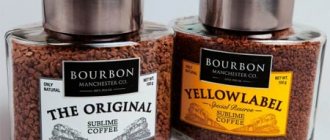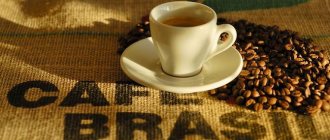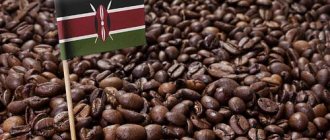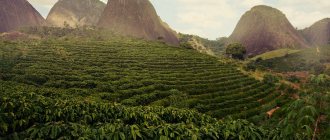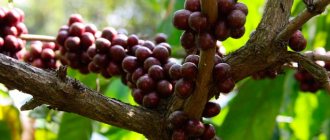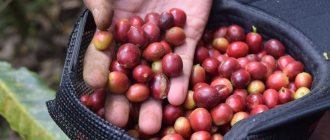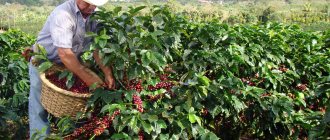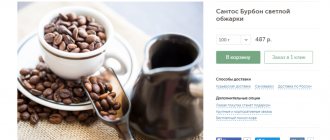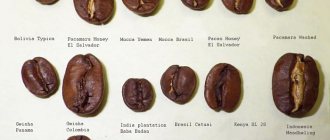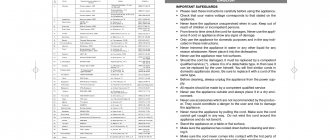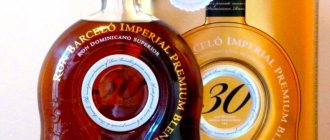Origin of Bourbon coffee
Bourbon coffee tree
This coffee is made from the seeds of the coffee tree, which has preserved its properties since ancient times.
It is believed that this plant, unlike other varieties, was not subjected to either artificial or natural crossing and remained the same as it once grew in distant Ethiopia.
In 1708, coffee tree seedlings brought from Yemen were planted in France on the island of Bourbon (now Reunion).
Later, the Bourbon coffee tree was secretly transported to Brazil, where it grows safely today.
Cultivation and collection
Nowadays, Yellow Bourbon is grown only in Brazil. The coffee plantations of this coffee are located in the highland region of Sul de Minas in the state of Minas Gerais.
It is grown at an altitude of 1000 to 2000 meters. It is quite susceptible to pests and diseases, so it requires a lot of attention from farmers. Harvesting takes place during the rainy season from October to March. This coffee is processed exclusively in a natural way.
The interesting thing is that Yellow Bourbon did not undergo any special crossing procedures and was obtained solely through natural mutations!
Bourbon yields about 25% less than regular Arabica because its berries are smaller. Their size is usually 16–18 mm. However, coffee experts believe that due to this it has an increased concentration of flavor qualities. The shape of the berry is more round, and the peel is thinner than that of ordinary Arabica varieties.
Description of Bourbon coffee
Instant Bourbon coffee
Bourbon coffee in its pure form has a special subtle and refined taste. It successfully combines spicy bitterness and delicate creamy softness.
Its special smoky aroma with amazing spicy sweetness cannot be confused with any other type of this drink.
The unique taste and special aroma are achieved due to the fact that the grains of the plant dry naturally, simply on tree branches.
The beans are collected manually. Plantations of Bourbon coffee seedlings are few in number. The cost of the final product is quite high.
Brazil is considered the world leader in growing this variety of coffee beans.
Brazilian plantation Bourbons
Brazilian Coffee
Brazil has been the largest coffee producer in the world and the second largest coffee market after the United States for more than 150 years. The country's share in global green coffee production is about 30%. Approximately 80% of Brazilian coffee is Arabica. There are approximately 6 billion coffee trees in the country...
According to a completely reliable romantic legend, a certain Brazilian officer, Francisco de Melo Palheta, was sent on a mission to French Guinea to supposedly resolve a border dispute. The true goal was to obtain coffee beans brought from another distant French colony - from the island of Bourbon (now Reunion). The French strictly guarded their plantations, and the Brazilian officer decided to act more sophisticatedly... At the farewell banquet, which was held before his return to Brazil, the first lady of Guinea presented him with a bouquet of flowers, which contained branches with the fruits of the coffee tree... Thus, the first coffee trees of the variety Bourbon appeared in Brazil in 1727.
The explosive development of the coffee industry has changed the entire country. First, millions of African slaves were brought to work on the plantations, and then, after the abolition of slavery, European immigrants from almost all European countries began to arrive as labor. Huge cities grew up, Rio de Janeiro, Sao Paulo, etc., but until the 1960s, more than half of Brazil's export earnings were earned from coffee.
Since Brazilian coffee is of high quality in itself, it is not grown on particularly high-mountain plantations, it does not stand out with bright sourness and has a very strong, balanced taste. These qualities make Brazilian coffee a very popular base, particularly for espresso blends. In addition, Brazilian green coffee is traditionally dry processed, which gives the coffee extra body. The consistently high quality of Brazilian coffee and advanced processing and sorting technologies, constant availability on the market make it very popular among coffee roasters around the world.
Named after the port city, Brazil Santos coffee is both a quality standard and a trademark of Brazilian coffee. Santos Grade 2 is traditionally the highest category. In addition, the description of the coffee indicates whether it is washed or dry, as well as “screen” or sieve (grain size).
Some plantations have voluntarily tightened the already very strict requirements for their products and sell coffee under their own brands, which usually coincide with the names of the plantations (Fazenda in Portuguese). Since the coffee trees on these plantations, almost without exception, belong to the traditional and very high-quality subspecies of Arabica - bourbon, these varieties of Brazilian coffee are also called “plantation bourbons”. These varieties are the best representatives of coffee from the world's leading coffee power. Plantation Bourbons have a soft, balanced taste with fruity undertones. They can be either wet, dry or intermediate levels of processing.
There is an opinion that Brazil is a country of large plantations and “coffee barons”. There certainly are, and some plantations are truly the largest in the world. But according to statistics from the Brazilian state of Minas Gerais, the vast majority of plantations, about 90%, were less than 50 hectares in area.
Types of Bourbon coffee
Those who want to try an amazing drink made from Bourbon coffee beans should know that there are several varieties of it.
Yellow Bourbon
Yellow Bourbon Coffee
Yellow Bourbon is a very rare type of coffee. It is grown on high mountain plantations.
Its peculiarity lies in the unusually thin skin of the berries, which allows the grains to absorb the heat of the sun's rays as much as possible.
Bourbon Santos
Bourbon Santos coffee
Bourbon Santos is produced from the fruits of trees no older than 4 years.
The beans of such trees do not have a very attractive appearance: they are small and slightly deformed.
But they have a pronounced taste and aroma with the inevitable sourness inherent in all varieties of Arabica coffee.
Flat Beat Santos
This type of drink is made from the fruits of the same trees, but older than 4 years.
The beans of such trees become larger and have a more regular shape.
Flat Beat Santos is stronger, does not have the characteristic sourness of Santos, but it acquires a tart, nutty flavor.
So, there won't be any specifics? Characteristics of Yellow Bourbon
Will. Usually, if it says “Bourbon Coffee” and means a specific variety of beans (or ground, it doesn’t matter), we are talking about “normal coffee,” that is, not a marketing, trade name for who knows what (see instant coffee “ Collection" at the beginning of the article), then they mean "Brazil Yellow Bourbon" .
Yellow Bourbon is a natural mutation of Bourbon noticed in the mountainous regions of southwest Brazil in 1859. A special feature is the thin skin of the berries. Because of this, the sun warms the pulp and grain more, more ultraviolet radiation passes through the skin, thereby increasing the specific amount of sugars. And vice versa, since the ripening rate is higher, less acids are formed.
By the way, there is also Orange Bourbon and Pink Bourbon, which belong to the “Colored Bourbons”. But there are many times fewer of them than yellow (of which there are also few). Readers may also have come across the term “Red Bourbon” somewhere - in fact, it’s just regular Bourbon.
The processing of Yellow Bourbon is usually natural, dry. Screen 16-18. Our roasters usually roast it under a filter or “omni” (medium-universal). It can be consumed in the form of espresso (including using as a base for milk drinks: cappuccino, latte), and prepared in a filter, as well as in a Turk and in an AeroPress. In general, whatever.
Brazil yellow bourbon from Bravos in cappuccino.
Description of taste and nuance
The dominant flavors are caramel, milk chocolate, sweet nuts - cashews, macadamia, green apple in the background, and ranetka in the aftertaste. The body of the drink is medium density, quite round. The taste is soft, balanced, even.
At the same time, you should not think that Yellow Bourbon is some kind of special coffee, a real microlot, etc. This is the most common “commercial” variety. He won't be able to surprise you. And to be honest, in principle he was not far from the usual Santos.
However, if the yellow variety of Bourbon is the same as regular Bourbon but just a little sweeter, then why is there so little of it? Why doesn't everyone grow Yellow Bourbon, sweetness is always good?
Because it is difficult to determine the ripeness of such berries. The ripeness of regular coffee is easy to understand by its color: green, then yellow, then light red, then rich red - pick it! And then, after turning green, the berry turns yellow and... then the color hardly changes. At the same time, a berry in this color can be either already ripe or completely unripe.
As a result, manual picking becomes more complicated and the number of unripe berries—Quakers—increases. And the taste, in fact, is not very different from the red variety of the same subspecies - regular Bourbon (or its other descendants grown in the same terroir).
Actually, Yellow Bourbon is typical specifically for Brazil, because mechanized collection by machines - harvesters - is in use there. And they collect everything, even the yellow variety, even the red one - the cost of the work does not increase.
However, if you want to independently compare how thin skin increases the sugar content in a yellow subspecies of seemingly the same Brazilian coffee, it is not so easy to do; the distribution of the variety in the Russian Federation leaves much to be desired.
Yellow Bourbon coffee (Brazil) - the rarest and one of the most unusual coffee varieties
Yellow Bourbon coffee is grown in just a few highland plantations in the southeastern regions of hot Brazil. In the ideal climatic conditions of the state of Minas Gerais, the berries of this coffee variety ripen earlier than the berries of other varieties, but the yield of the bushes is smaller and the bean caliber is no more than 16. (For elite varieties, 18-caliber beans are usually selected). The birthplace of Yellow Bourbon is Yemen, from where it was brought to the island of Bourbon (French Guiana) in 1715, and then began to be cultivated in Brazil. It is interesting that there are no plantations of this capricious variety preserved neither in Yemen nor in Bourbon.
